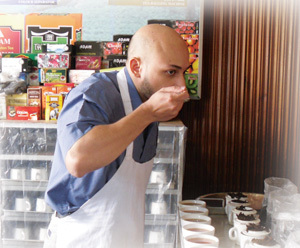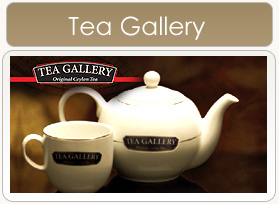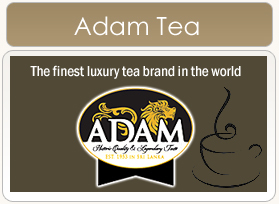ADAM TEA
Adam Tea proudly manufactures and exports Black, Green, White (Silver Tip), and flavored teas internationally. We package and supply for every type of buyer. Specializing in private label, we can implement your designs or produce custom packaging (co-packing) to order.
TEA TASTING

Tea Tasting – Like wine tasting- is an art perfected through years of experience. It’s possibly even more difficult than wine tasting, simply because tea is a drink full of flavor complexities and subtle nuances-a fact often overlooked by many tea drinkers. The drink is generally described as having three main flavor dimensions-being a foreground (top note), middle ground and background flavor, all of which blend together to create a tea’s individual flavor profile. Again, like wine, individual preferences are the best way to select the perfect brew for you.
Professional Tea tasters in Sri Lanka, on an average day, would sample over 300 types of tea, and only the best are marked for purchase. This process is an important part of the commercial aspect of tea by which the worthiness of a particular tea is assessed and valued.
EXPERIENCE
Drawing from an impressive 30 years in packing and shipping Pure Ceylon Tea across the world. Adam Tea has a sturdy background of being a true leader in selling the world’s healthiest natural beverage. With consistent quality our naturally refreshing teas are an asset to your day, and benefit to your life!

A SHORT HISTORY IN THE BEGINNING
The discovery of tea was something of an accident. According to legend, in 2737 BC, the Chinese Emperor Shen Nung was boiling water over an open fire when a few leaves from a Camellia Sinensis plant fell into the pot of hot water. The emporer drank the mixture and found it gave him vigor of body, contentment of mind and determination of purpose. Thus the belief of the tea’s mysterious healing powers was established. This is how tea first became popularized as a healthy soothing beverage for all occasions and still is. The first book on tea (Ch’a Ching) was written centuries later, in 780 AD by Chinese poet Lu Yu. It included a description of the cultivation, preparation and intake of tea.
By the 8th century, commercial cultivation of tea had spread through China and into Japan where it was considered to be a luxury, only to be enjoyed by Japan’s nobility and holy men. Its popularity spread to the common folk when word of its health benefits became known.
ORIGIN OF CEYLON TEA- A NEW ERA DAWNS
Now being recognized as possibly the healthiest beverage to drink, tea has come a long way since its introduction to Sri Lanka.
Tea is synonymous with Sri Lanka and the island’s most celebrated export during the colonial era, accounting for much of Ceylon’s prosperity. Introduced as a commercial crop in the late 19th century, it took a while before plantation owners saw the benefit of the crop. It eventually became the country’s premier agricultural product only because the main plantation crop, coffee, had been crippled by a blight referred to as “ Devastating Emily”, forcing planters to look for another viable crop to cultivate.
Today, Sri Lanka is amongst the largest tea exporting countries in the world. Tea Estates across Sri Lanka produce a wide variety of blends, encompassing everything from black tea, green tea & silver tips! In the country, tea is mainly grown in estates located amidst lush, rolling hills, where tea estates dot the landscape. However, this versatile crop is also grown in lower altitudes in certain parts of the country.
FROM THE HILLS TO THE COAST
What is now believed to be the finest grade of tea produced in the country, known as “high grown” tea, is produced at high altitudes since the wetter climate, abundance of sunshine and well-drained soils provide perfect conditions. A lot of tea produced in Sri Lanka comes from many of the colonial styled tea estates that still exist amongst the beautiful mountainous regions of Nuwara Eliya, Dimbula, and Dickoya.
Each region produces a distinct flavor, aroma, and color resulting in a wide range in the different grades of tea produced here.Tea in Sri Lanka is also grown in the lower altitude as well. Tea estates are found across the Central and Southern regions such as Sabragamuwa, Ratnapura and even in Galle. The tea plantations, which are small in this region, are surrounded by beautiful vegetation. While the teas produced here are known as “low grown”, it is not inferior quality, and low grown tea is quite in demand at the tea auctions that occur in the country.
HEALTH BENEFITS OF CEYLON TEA
BLACK, GREEN & WHITE TEAS FOR A HEALTHY LIFESTYLE
Tea has many important vitamins, minerals, and antioxidants needed for a healthy body. This is why tea has been used as a medicine for many years and is, with the backing of modern research, still being used for that reason. Drinking tea has been associated with good oral health and prevention of certain cancers and heart disease.
ANTIOXIDANTS
Oxidation of our body elements results in the formation of very reactive substances known as free radicals. Free radicals cause damage to our cells, which can eventually lead to heart disease and cancer. Antioxidants found in our diet help prevent free radical attacks. Vitamins A, C, and E are popular antioxidants. Both green and black teas also contain antioxidants known as Flavonoids, which play a critical role in protecting us from heart disease and cancer.
VITAMINS
Black tea contains the vitamins listed below. Each has an important unique function necessary for maintaining good health.
CAROTENE:- A precursor to Vitamin A ( Retinol) serves as an antioxidant
THIAMINE (B1) AND RIBOFLAVIN(B2): – Both play an integral part in releasing energy from food.
VITAMIN C: – Is important in maintaining a healthy immune system. It functions as an
Antioxidant that aids detoxification and acts as a structural component in the collagen fibers of gums.
FOLIC ACID: PANTOTHENIC- Plays a role in cell division and amino acid synthesis.
NICOTINIC ACID AND PANTOTHENIC ACID: – Are important for the release of energy from carbohydrates and fats.
MINERALS
Tea is also a rich source of three very important minerals.
MANGANESE: – Is a co-factor for an enzyme known to prevent oxidative damage. Drinking several cups of tea a day can provide you with almost half your daily manganese requirements.
POTASSIUM:- Is one of the body’s main electrolytes and thus plays a critical role in water balance as well as the body’s acid-base balance. Potassium is also necessary for the transmission of nerve impulses. Deficiency results in aberrant heartbeats, fatigue, and localized cramping.
FLUORIDE: – Is another mineral found in great abundance in tea. In fact, tea is one of the very few natural sources of fluoride. Fluoride has made its mark as the most successful agent against tooth decay. Scientists encourage drinking tea to improve oral health and to prevent tooth and gum decay.
QUALITY AND SAFETY- A WAY OF LIFE!
To live up to the ideals set by the Values and Beliefs of the Adamexpo group, a strict Hazard Analysis & Critical Control Point (HACCP) food safety management standard has been enforced, to ensure that our customers receive the very finest quality teas.
Our standards are accepted as being compliant with industry standards internationally. Adam Tea has received certification by TUV SUD for an established HACCP system for “Purchasing, Blending, Flavouring, Regrading, Packing and Dispatch” of processed teas. We guarantee that every single batch of tea is produced under the highest and most stringent safety measures available today.
Our Brands



Contact
- +94 11 760 8500
- +94 11 793 0670
Address
No. 370, Sedawatta
Road,
Wellampitiya,
Sri
Lanka.
